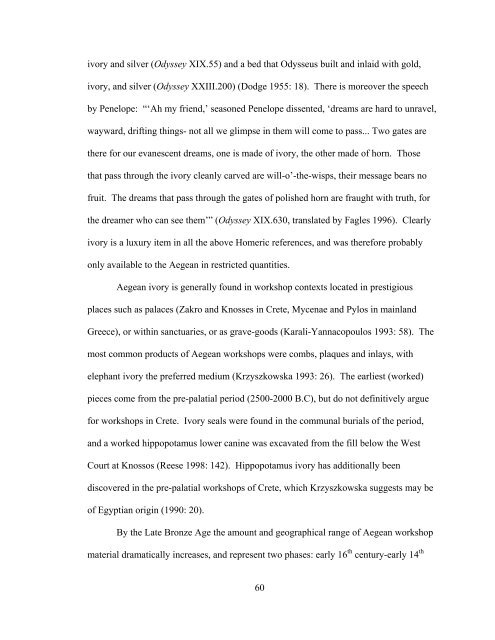Tracing the Source of the Elephant And Hippopotamus Ivory from ...
Tracing the Source of the Elephant And Hippopotamus Ivory from ...
Tracing the Source of the Elephant And Hippopotamus Ivory from ...
Create successful ePaper yourself
Turn your PDF publications into a flip-book with our unique Google optimized e-Paper software.
ivory and silver (Odyssey XIX.55) and a bed that Odysseus built and inlaid with gold,<br />
ivory, and silver (Odyssey XXIII.200) (Dodge 1955: 18). There is moreover <strong>the</strong> speech<br />
by Penelope: “‘Ah my friend,’ seasoned Penelope dissented, ‘dreams are hard to unravel,<br />
wayward, drifting things- not all we glimpse in <strong>the</strong>m will come to pass... Two gates are<br />
<strong>the</strong>re for our evanescent dreams, one is made <strong>of</strong> ivory, <strong>the</strong> o<strong>the</strong>r made <strong>of</strong> horn. Those<br />
that pass through <strong>the</strong> ivory cleanly carved are will-o’-<strong>the</strong>-wisps, <strong>the</strong>ir message bears no<br />
fruit. The dreams that pass through <strong>the</strong> gates <strong>of</strong> polished horn are fraught with truth, for<br />
<strong>the</strong> dreamer who can see <strong>the</strong>m’” (Odyssey XIX.630, translated by Fagles 1996). Clearly<br />
ivory is a luxury item in all <strong>the</strong> above Homeric references, and was <strong>the</strong>refore probably<br />
only available to <strong>the</strong> Aegean in restricted quantities.<br />
Aegean ivory is generally found in workshop contexts located in prestigious<br />
places such as palaces (Zakro and Knosses in Crete, Mycenae and Pylos in mainland<br />
Greece), or within sanctuaries, or as grave-goods (Karali-Yannacopoulos 1993: 58). The<br />
most common products <strong>of</strong> Aegean workshops were combs, plaques and inlays, with<br />
elephant ivory <strong>the</strong> preferred medium (Krzyszkowska 1993: 26). The earliest (worked)<br />
pieces come <strong>from</strong> <strong>the</strong> pre-palatial period (2500-2000 B.C), but do not definitively argue<br />
for workshops in Crete. <strong>Ivory</strong> seals were found in <strong>the</strong> communal burials <strong>of</strong> <strong>the</strong> period,<br />
and a worked hippopotamus lower canine was excavated <strong>from</strong> <strong>the</strong> fill below <strong>the</strong> West<br />
Court at Knossos (Reese 1998: 142). <strong>Hippopotamus</strong> ivory has additionally been<br />
discovered in <strong>the</strong> pre-palatial workshops <strong>of</strong> Crete, which Krzyszkowska suggests may be<br />
<strong>of</strong> Egyptian origin (1990: 20).<br />
By <strong>the</strong> Late Bronze Age <strong>the</strong> amount and geographical range <strong>of</strong> Aegean workshop<br />
material dramatically increases, and represent two phases: early 16 th century-early 14 th<br />
60

















